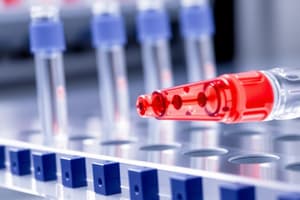Podcast
Questions and Answers
In a competitive immunoassay, what is the relationship between the amount of bound label and the concentration of labeled antigen?
In a competitive immunoassay, what is the relationship between the amount of bound label and the concentration of labeled antigen?
- The amount of bound label is directly proportional to the concentration of the labeled antigen.
- The amount of bound label is independent of the concentration of the labeled antigen.
- The amount of bound label is exponentially proportional to the concentration of the labeled antigen.
- The amount of bound label is inversely proportional to the concentration of the labeled antigen. (correct)
What is the primary advantage of using homogeneous immunoassays over heterogeneous immunoassays?
What is the primary advantage of using homogeneous immunoassays over heterogeneous immunoassays?
- Homogeneous immunoassays are less susceptible to interfering substances.
- Homogeneous immunoassays offer higher sensitivity in complex biological matrices.
- Homogeneous immunoassays do not require a physical separation step. (correct)
- Homogeneous immunoassays require a physical separation step of bound and free components.
In indirect ELISAs, why is the assay termed 'indirect'?
In indirect ELISAs, why is the assay termed 'indirect'?
- Because the enzyme-labeled reagent does not participate in the initial antigen-antibody reaction. (correct)
- Because the solid phase is coated with a secondary antibody instead of the primary antibody.
- Because the assay detects the amount of antigen present in the sample indirectly through a secondary reaction.
- Because the enzyme-labeled reagent directly binds to the antigen of interest.
What is a potential cause of unpredictable interferences in immunoassays that utilize a biotin-streptavidin (SAv) complex?
What is a potential cause of unpredictable interferences in immunoassays that utilize a biotin-streptavidin (SAv) complex?
What principle underlies fluorescence polarization immunoassays (FPIA)?
What principle underlies fluorescence polarization immunoassays (FPIA)?
In the context of immunoassays, what does 'cross-reactivity' refer to?
In the context of immunoassays, what does 'cross-reactivity' refer to?
How do single-use test kit immunoassays ensure proper functionality before results are reported?
How do single-use test kit immunoassays ensure proper functionality before results are reported?
In capture or sandwich immunoassays, what configuration creates the 'sandwich'?
In capture or sandwich immunoassays, what configuration creates the 'sandwich'?
What is the role of enzymes in enzyme immunoassays (EIAs)?
What is the role of enzymes in enzyme immunoassays (EIAs)?
What is the 'high-dose hook effect' (or postzone effect) primarily associated with in immunoassays?
What is the 'high-dose hook effect' (or postzone effect) primarily associated with in immunoassays?
Flashcards
Analyte
Analyte
A substance being measured in an immunoassay.
Heterogeneous Immunoassays
Heterogeneous Immunoassays
Immunoassays where physical separation of bound and free components is required.
Homogeneous Immunoassay
Homogeneous Immunoassay
A type of immunoassay that requires no physical separation of bound and free components.
Competitive Immunoassays
Competitive Immunoassays
Signup and view all the flashcards
Noncompetitive Immunoassays
Noncompetitive Immunoassays
Signup and view all the flashcards
Cross-reactivity
Cross-reactivity
Signup and view all the flashcards
Fluorochromes
Fluorochromes
Signup and view all the flashcards
Direct Immunofluorescence Assays
Direct Immunofluorescence Assays
Signup and view all the flashcards
Indirect Immunofluorescence Assays
Indirect Immunofluorescence Assays
Signup and view all the flashcards
Multiplex Immunoassay (MIA)
Multiplex Immunoassay (MIA)
Signup and view all the flashcards
Study Notes
- Labeled immunoassays can measure small antigens and antibodies, even in low concentrations
Analyte
- The substance being measured in an immunoassay is called the analyte
Labeling Techniques
- Labeling techniques for immunoassays include radioactivity, enzymes, fluorescence, chemiluminescence, and chromatography
Immunoassay Formats
- Immunoassays are either heterogeneous or homogeneous
- Heterogeneous immunoassays require physical separation of bound and free components
- Homogeneous immunoassays do not require physical separation
Competitive & Noncompetitive Immunoassays
- Immunoassay method designs are subclassified as competitive or noncompetitive
- Competitive immunoassays involve adding all reactants simultaneously
- Labeled antigen competes with patient antigen for a limited number of antibody-binding sites
- In competitive immunoassays, the amount of bound label is inversely proportional to the concentration of the labeled antigen; more labeled antigen detected indicates less antigen is present in the patient sample
Noncompetitive Immunoassays
- Reagent antibody is passively absorbed onto a solid-phase material
- Excess capture antibody is present to ensure patient antigen will be bound
- A labeled antibody, directed against a different epitope of the antigen, is added
- The amount of label detected is directly proportional to the amount of patient antigen present
Antibodies
- Antibodies used in immunoassays must be specific and have a high affinity for the antigen
- High specificity reduces cross-reactivity, while affinity determines the stability of binding between antigen and antibody
- Specificity and affinity determine the sensitivity of immunoassays
Radioimmunoassays (RIAs)
- RIAs are based on a competitive principle and use a radioisotope label
- RIAs have high analytical sensitivity but inherent disadvantages due to the use of radioactive substances
Enzyme Immunoassays (EIAs)
- EIAs use enzymes to catalyze biochemical reactions
- They convert reagent substrates to produce chemically modified products that can be detected
Competitive Enzyme-Linked Immunosorbent Assays (ELISAs)
- Antigen in the sample competes with enzyme-conjugated antigen for a limited number of binding sites on antibody molecules attached to a solid phase
- Enzyme activity catalyzes the conversion of the substrate to a detectable product
Indirect ELISAs
- These are a type of noncompetitive immunoassay
- The enzyme-labeled reagent does not participate in the initial antigen-antibody reaction
- The associated antigen is bound to the solid phase
- Patient serum with an unknown antibody concentration is added
- A second antibody reacts with any patient antibody that is bound to the solid phase
Capture Immunoassays
- Capture immunoassays detect antigen
- The antibody is bound to a solid phase, and patient antigen is allowed to bind or be captured
- A second enzyme-labeled antibody is added
- The final complex forms a "sandwich" with the sample antigen between the two reagent antibodies
Homogeneous Enzyme Immunoassays
- These require no separation step
- Enzyme activity changes as specific antigen-antibody binding occurs
- Steric hindrance results in a loss of enzyme activity when antibody binds to enzyme-labeled antigen
Analytical Sensitivity
- Increased analytical sensitivity can be achieved by complexing biotin to the capture antibody and streptavidin to the solid-phase material
- Biotin-SAv labeling can be used in both indirect ELISAs and capture immunoassays
High-Dose Hook Effect
- The most commonly observed limitation of capture immunoassays
- Excess patient antigen causes falsely decreased detection, leading to an analyte concentration that appears low or normal
Antibody Interference
- Antibodies produced in vivo may interfere with immunoassays if similar to a test reagent
- Heterophile interference occurs when the individual produces antibodies similar to those used in the test reagent kit
- Test kits using a biotin-SAv complex can cause unpredictable interferences
Cross-Reactivity
- Cross-reactivity describes the detection of a substance other than the analyte of interest, typically a false-positive result
Homogeneous Immunoassays
- Used for detecting low-molecular-weight analytes such as hormones, therapeutic drugs, and drugs of abuse
- The cloned-enzyme donor immunoassay (CEDIA) is an example
Heterogeneous Enzyme Immunoassays
- One-step, easy-to-interpret formats which are Rapid immunochromatographic
- Test devices can capture antigen or antibody in a specific location on a membrane
Immunometric Assays
- Most are based on chemiluminescent label detection
- Chemiluminescence is produced by certain compounds when oxidized, serving as markers similar to RIA and EIAs
Fluorochromes
- Fluorescent compounds that absorb energy from an incident light source and convert that energy to light of a longer wavelength
Direct Immunofluorescence Assays
- Involve antigen detection through a specific antibody labeled with a fluorescent tag
- The presence of fluorescence is detected with a fluorescent microscope that utilizes UV light
Indirect Immunofluorescent Assays
- The original antibody is unlabeled
- Incubation with antigen is followed by addition of a second fluorescent-labeled anti-immunoglobulin that detects antigen-antibody complexes
Multiplex Immunoassay (MIA)
- Uses polystyrene beads as the solid phase
- Beads conjugated to different antigens detect antibodies in patient serum
- MIA technology allows simultaneous detection of multiple antibodies or antigens
Fluorescence Polarization Immunoassay (FPIA)
- Was a type of homogeneous fluorescent immunoassay based on the principle that polarization of light increases when an antigen is bound to antibody
Newer Immunoassays
- Single-use disposable immunoassays are rapid tests based on immunochromatography
- Designed to detect analytes such as hCG and drugs in urine
Homogeneous EIA
- No physical separation step of bound and labeled antigens required
- Patient antigen and labeled antigen react with reagent antibody in solution
- Enzyme label is inactivated when reagent antigen binds to antibody
- Patient antigen concentration is directly proportional to the signal
Heterogeneous Immunoassay
- Requires solid-phase material to allow for antigen or antibody binding
- Includes both competitive and noncompetitive immunoassay designs
- In a noncompetitive immunoassay, the concentration of patient antigen is directly proportional to the signal
- In a competitive immunoassay, patient antigen concentration is indirectly proportional to the signal
Competitive Immunoassay
- Patient antigen (Ag) competes with labeled antigen (Ag*) for limited antibody-binding (Ab) sites
- Final detected signal is AgAb (labeled antigen bound to antibody), as shown in the reaction: Ag, Ag, Ab→Ag*Ab + AgAb
- The more patient antigen is present, the less label is detected
Noncompetitive, Indirect ELISA for Antibody Detection
- Excess solid-phase antigen binds patient antibody, and a second labeled antibody (anti-human immunoglobulin) is added
- All patient antibody is allowed to bind
- Amount of label is directly proportional to the amount of patient antibody present
Capture or Sandwich Immunoassay
- Excess solid-phase antibody binds patient antigen, and a second labeled antibody (to the antigen) is added after a wash step
- All patient antigen is allowed to bind
- Amount of label is directly proportional to the amount of patient antigen present
Enzyme-Multiplied Immunoassay Technique (EMIT)
- Reagent antigen is bound to an enzyme tag
- Change in enzyme activity is observed as specific antigen-antibody interaction occurs in solution
- All patient antigen is allowed to bind
- Amount of signal generated is directly proportional to the amount of patient antigen present
- If reagent antibody binds to the enzyme-antigen pair, enzyme activity is blocked, otherwise, enzyme is active
- Active enzyme (commonly glucose-6-phosphate dehydrogenase) catalyzes the reduction of NAD+ to NADH, leading to increased absorbance in the UV-wavelength region
Direct Immunofluorescence
- Patient sample (e.g., tissue) is attached to a slide, and specific fluorescent-labeled antibody is added
- In cell-based immunoassays, patient cells are incubated with fluorescent-labeled antibody to a cell surface antigen
- If fluorescence is detected, patient sample is positive for the antigen
- Fluorescence on cell surfaces indicates that the cell is positive for the antigen
Indirect Immunofluorescence
- To detect patient antibody, reagent antigen is attached to a slide and incubated with the patient sample, then a second fluorescent-labeled antibody (anti-human immunoglobulin) is added
- To detect antigen, patient sample is fixed to a slide and incubated with antibody to the antigen (primary antibody), followed by labeled secondary antibody, directed against the primary antibody
- If fluorescence is detected, antibody or antigen is present in the sample, and the test is positive
Fluorescence Polarization
- Fluorescent-labeled antigen competes with patient antigen for a limited number of soluble antibody-binding sites
- When patient antigen binds to antibody, less reagent-labeled antigen binds, and less polarized light will be detected
- The relationship is an Inverse ratio between patient antigen and amount of polarization
Rapid Immunochromatographic
- Patient sample is added to a test strip and migrates through the strip
- Patient antigen complexes to antibody-labeled particles or competes with antigen- Presence of test line may indicate either positive or negative result, depending on manufacturer design
Studying That Suits You
Use AI to generate personalized quizzes and flashcards to suit your learning preferences.




